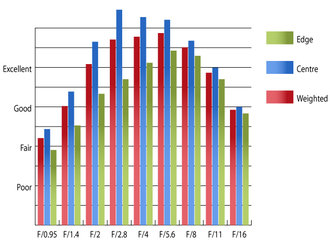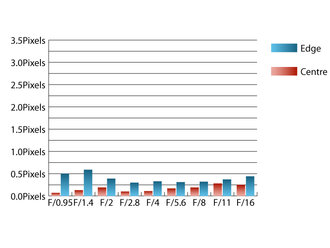Voigtlander 25mm f/0.95 Nokton Micro Four Thirds Lens Review
Voigtlander 25mm f/0.95 Nokton Micro Four Thirds Lens Performance
As is common with lenses that sport a very fast maximum aperture, images taken at f/0.95 have a dreamy appearance, probably due to high levels of spherical aberrations. These spherical aberrations reduce the overall sharpness of the lens at fast apertures and can even cause issues with accurate focusing. At f/0.95 the clarity delivered can only be described as fairly good in the centre and just about fair towards the edges of the frame. Still, for the right subject, in the right conditions this lens is still quite usable at maximum aperture.Stopping down the aperture results in a marked increase in sharpness and contrasts. With the aperture set to f/1.4 sharpness in the centre is already approaching very good levels and fairly good levels of clarity are produced towards the edges of the frame. Peak sharpness is achieved with the aperture set to f/5.6, where the clarity produced is outstanding across the frame. Unfortunately, far into the corners never really sharpness up, and even at f/5.6 they can look quite soft.
 Resolution at 25mm | How to read our chartsThe blue column represents readings from the centre of the picture frame and the green is from the edges. Averaging them out gives the red weighted column.The scale on the left side is an indication of actual image resolution. The taller the column, the better the lens performance. Simple. For this review, the lens was tested on a Panasonic Lumix DMC-G3 using Imatest. |
Chromatic aberrations are very well controlled for a lens with such a fast maximum aperture. At their worst, CAs cover 0.59 pixel widths towards the edges of the frame at f/1.4. This low level of fringing should cause few issues, even in images with high contrast edges towards peripheral areas of the frame.
 Chromatic aberration at 25mm | How to read our chartsChromatic aberration is the lens' inability to focus on the sensor or film all colours of visible light at the same point. Severe chromatic aberration gives a noticeable fringing or a halo effect around sharp edges within the picture. It can be cured in software.Apochromatic lenses have special lens elements aspheric, extra-low dispersion etc. to minimize the problem, hence they usually cost more. For this review, the lens was tested on a Panasonic Lumix DMC-G3 using Imatest. |
Falloff of illumination towards the corners of the frame is pretty well controlled, given the extremely fast maximum aperture. At f/0.95 the corners are 2.54 stops darker than the centre of the frame and illumination is visually uniform with the aperture stopped down to f/2.8 and beyond.
Typically of lenses with a fast maximum aperture, slight barrel distortion is present. Imatest detected 1.71% barrelling, which can occasionally pose issues, especially when shooting close up. The distortion pattern is uniform across the frame, so applying corrections in image editing software afterwards should be pretty straightforward.
Flare and loss of contrast when shooting into the light are rarely an issue with this lens and the supplied hood does a pretty good job of shielding the front element from extraneous light that may cause issues. Contrast levels drop at wider apertures in all shooting conditions, which is fairly typical of very fast lenses and may even be considered to add to the effect produced.
Add your message
Login required
Please login here or if you've not registered, you can register here. Registering is safe, quick and free.
Please login here or if you've not registered, you can register here. Registering is safe, quick and free.
photodo Stats
1102 lenses
428 MTF tests
74 in-depth photodo reviews
100+ users join each day
Help the lens community by reviewing or rating a lens today via our lens search
428 MTF tests
74 in-depth photodo reviews
100+ users join each day
Help the lens community by reviewing or rating a lens today via our lens search
Latest Lens Reviews
- Chinon 28mm f/2.8 Vintage Lens Review
- Canon EF 70-200mm f/4L IS II USM Lens Review
- Samyang AF 85mm f/1.4 EF Review
- Sigma 70mm f/2.8 DG Macro Art Review
- Samyang AF 24mm f/2.8 FE Review
- Meike 50mm f/1.7 Review
- Tamron 70-210mm f/4 Di VC USD Review
- Lensbaby Burnside 35mm f/2.8 Review
- Asahi Super Takumar 50mm f/1.4 Review
- Asahi Super-Multi-Coated Takumar 135mm f/3.5 Review
